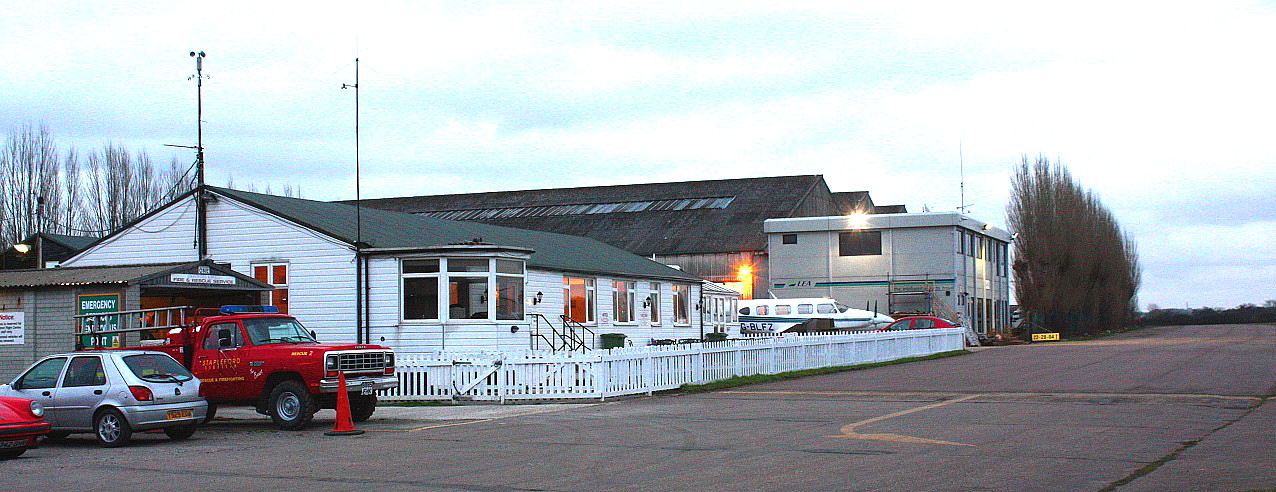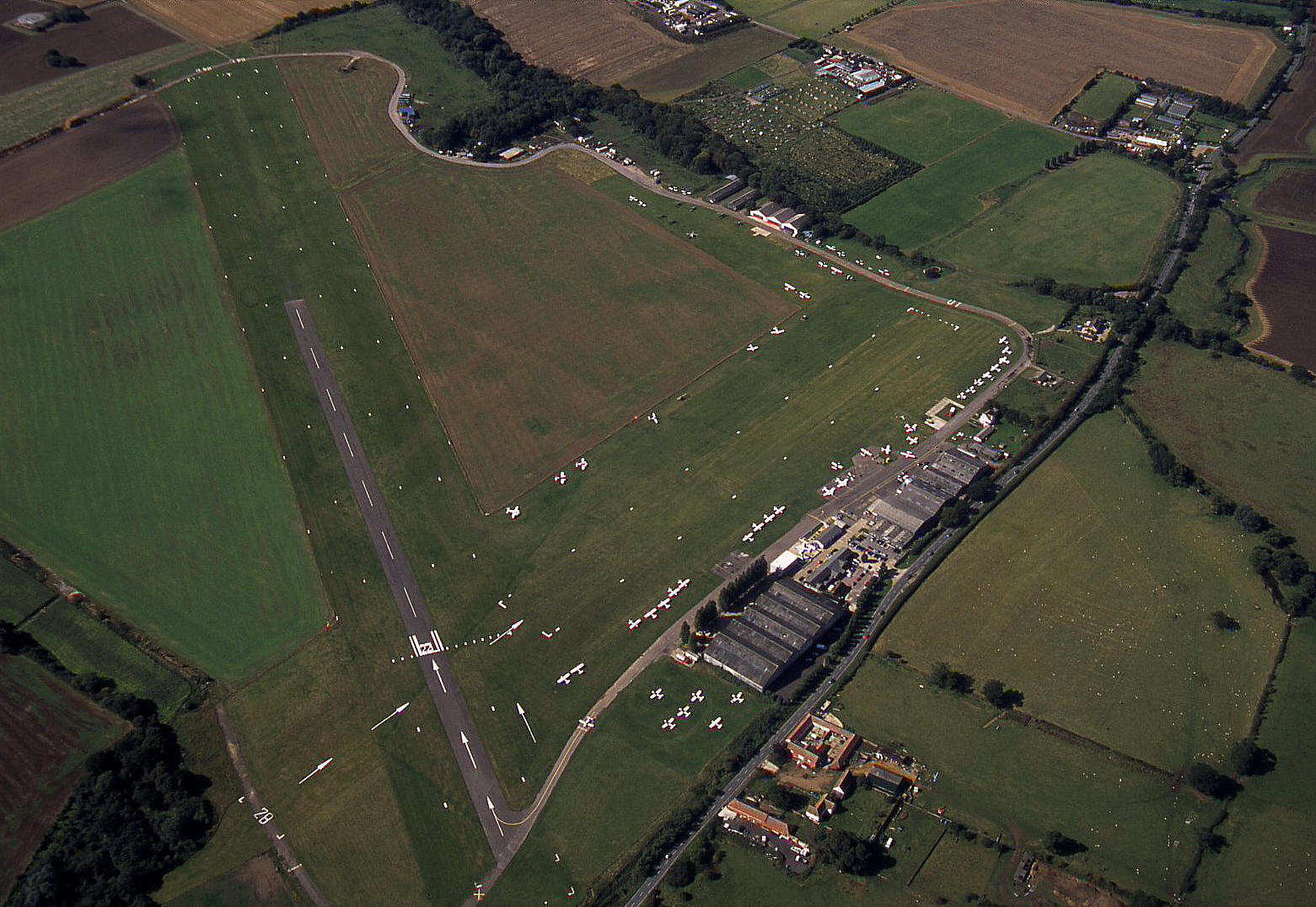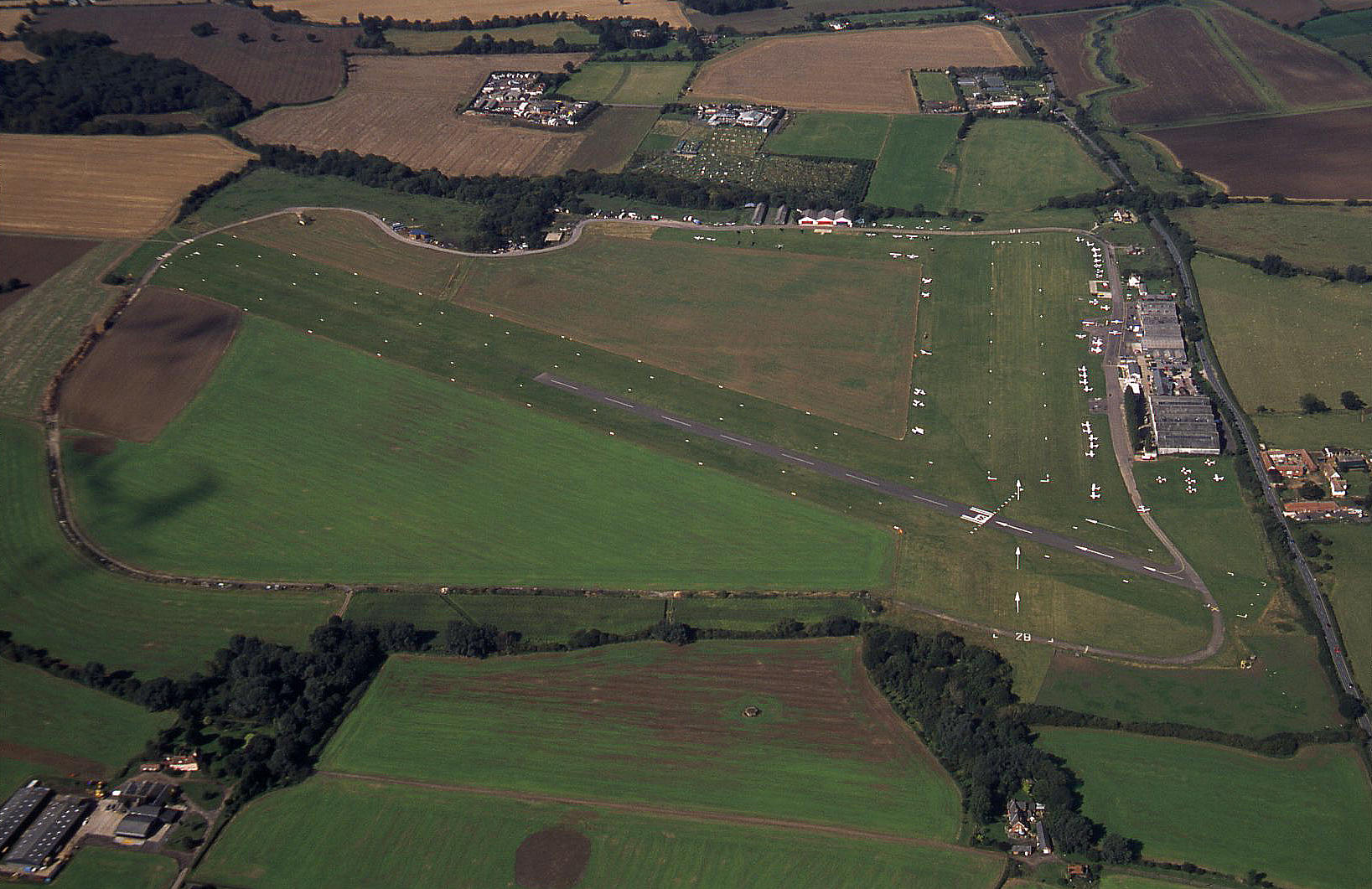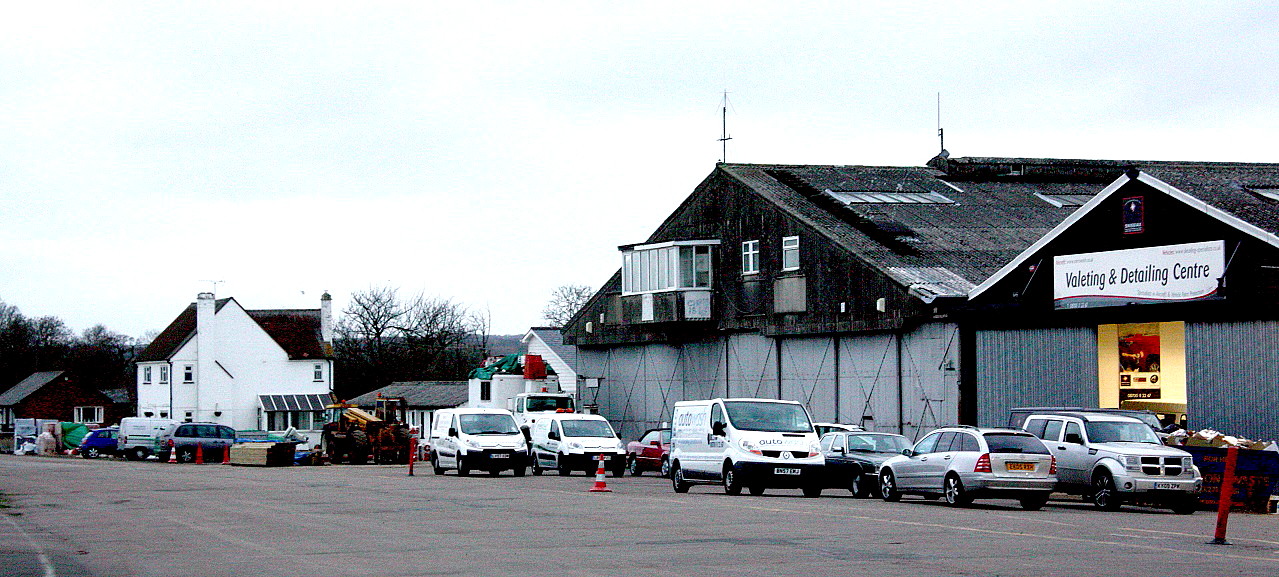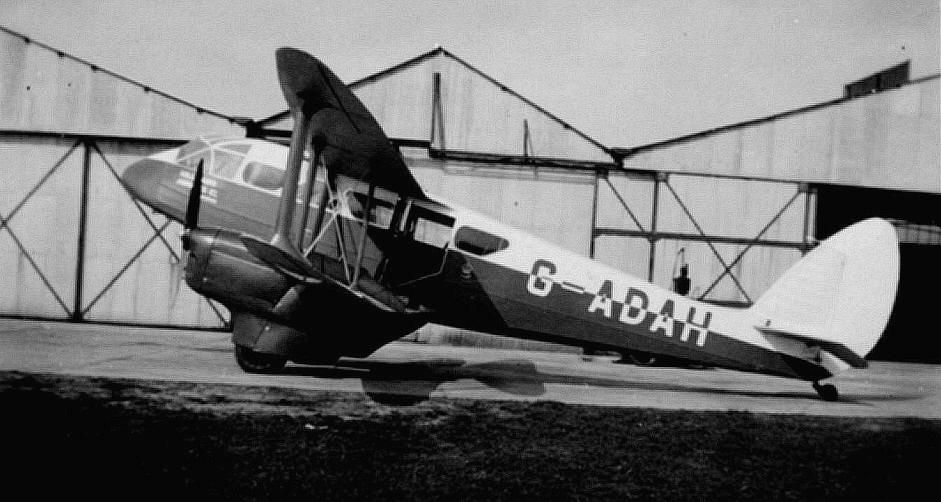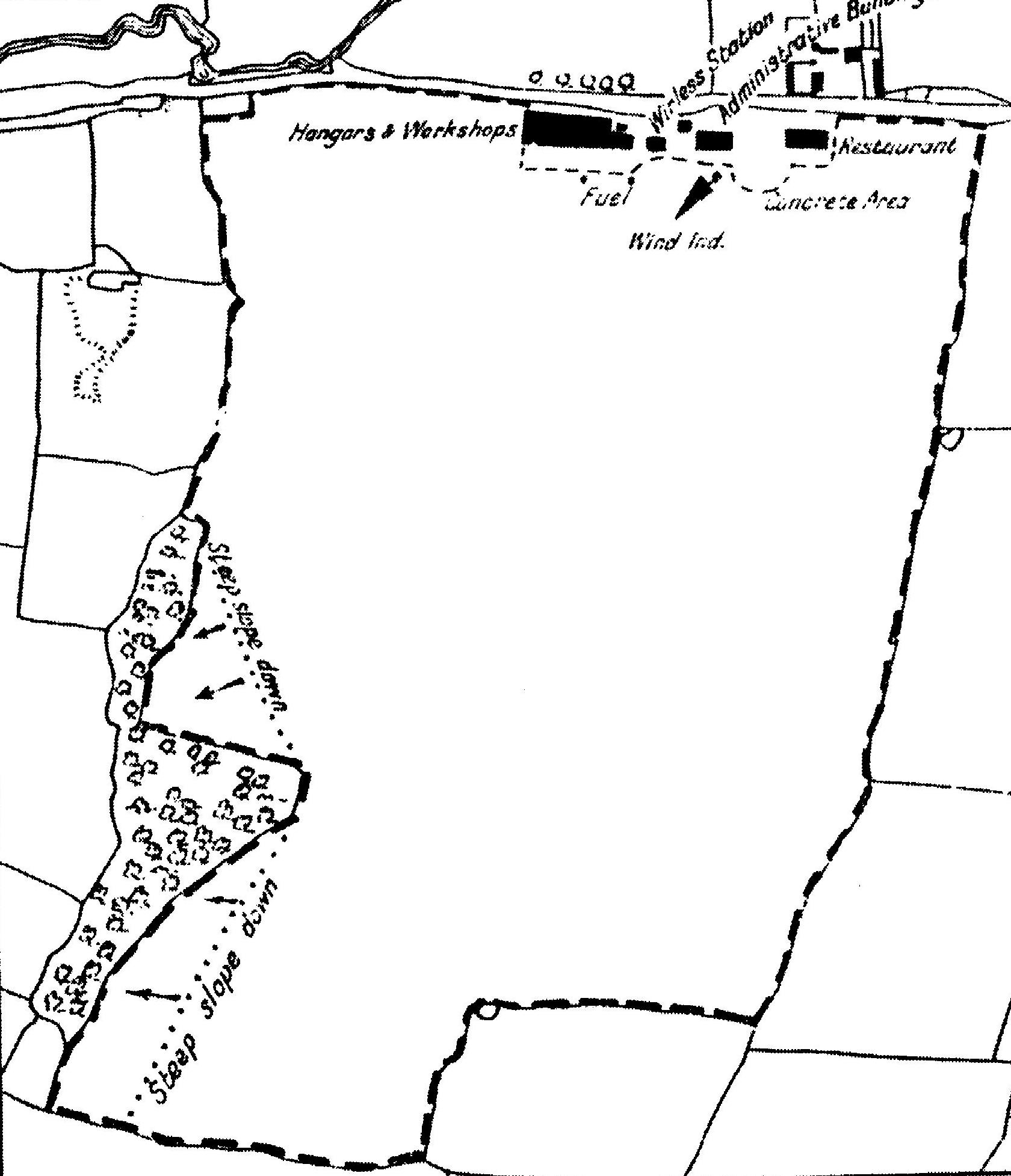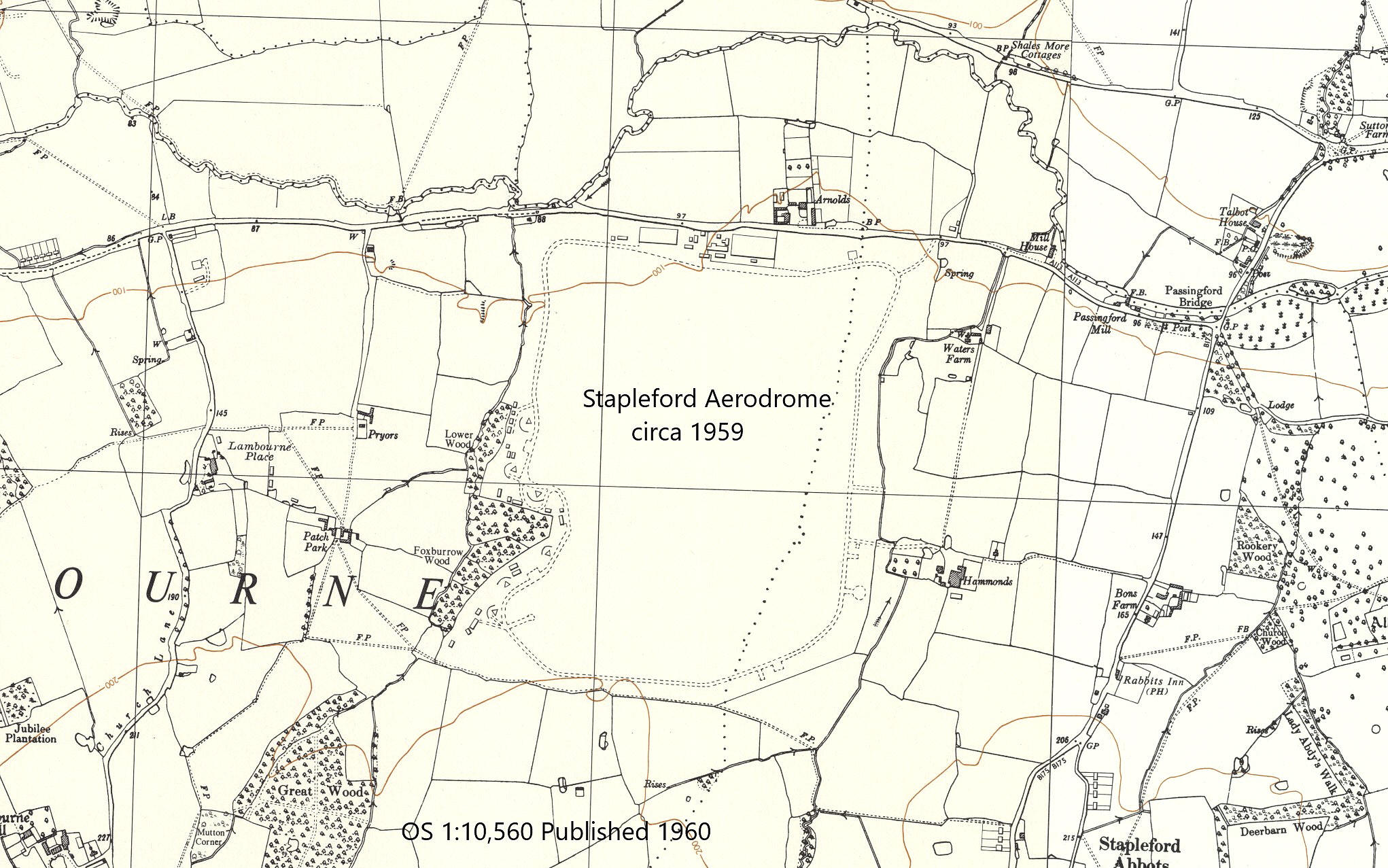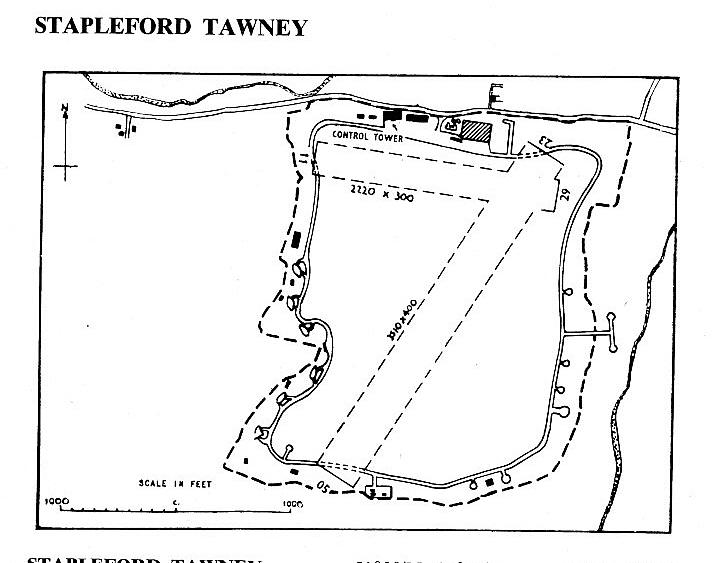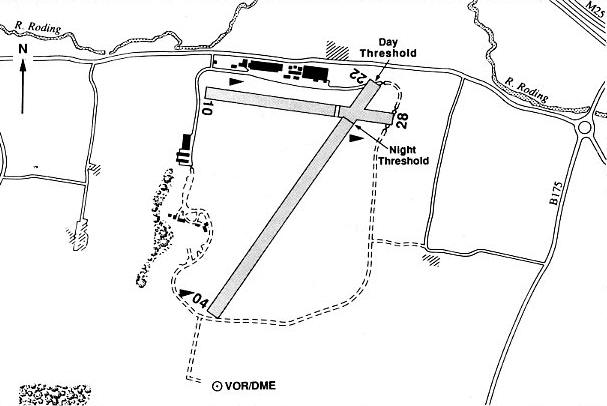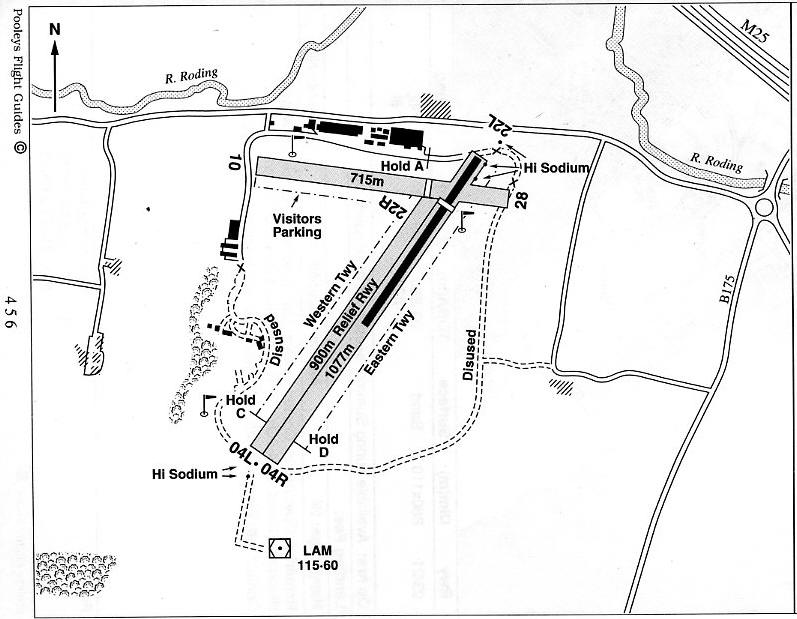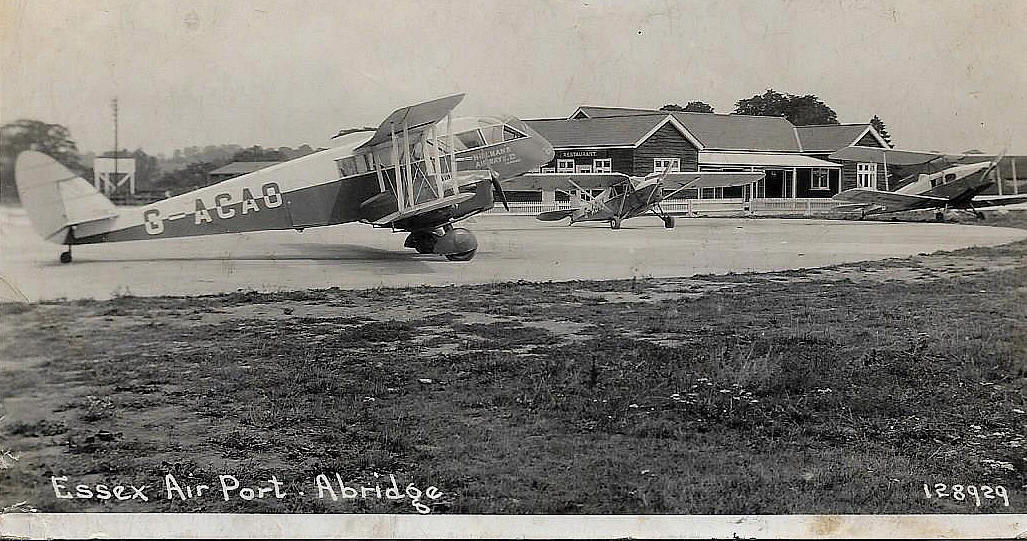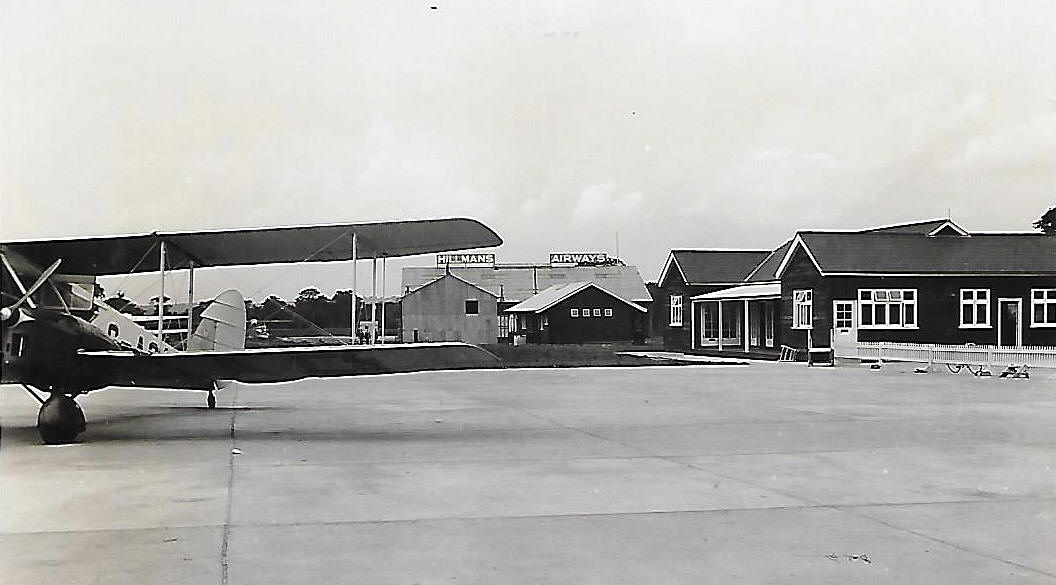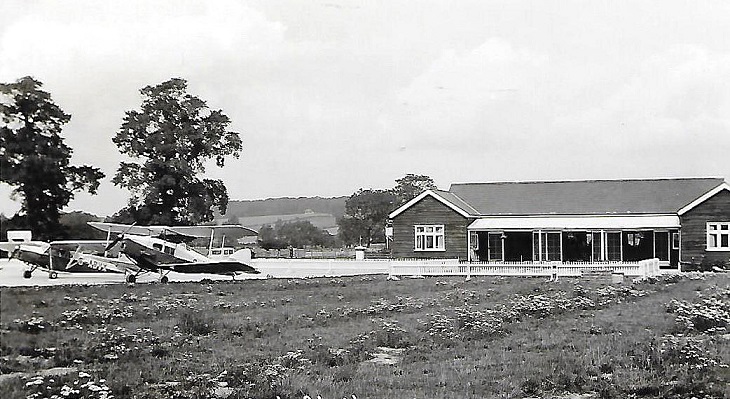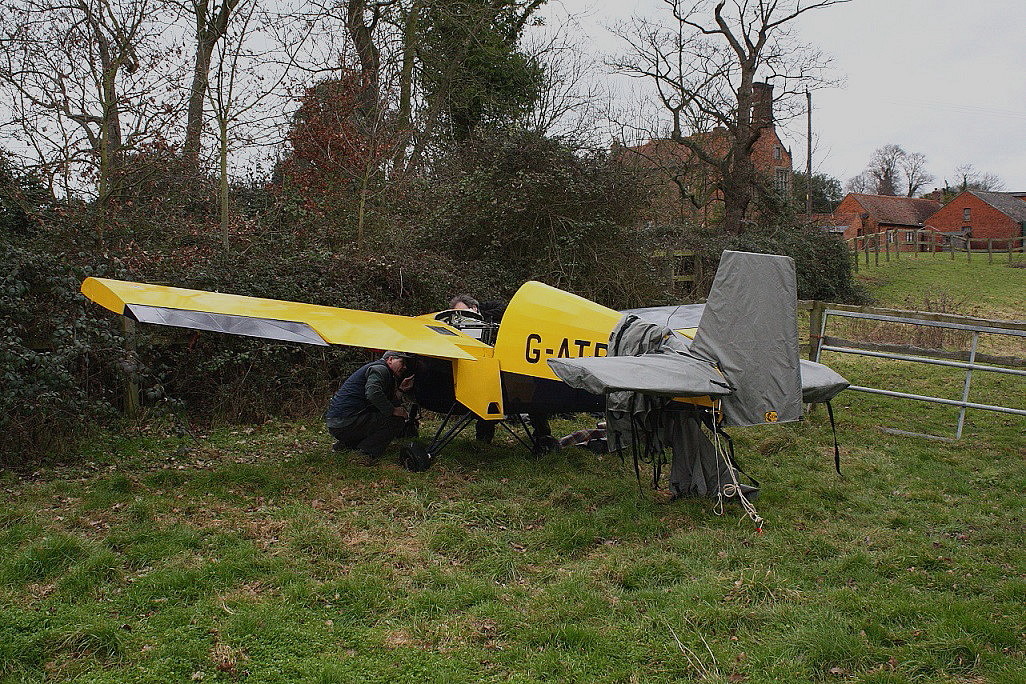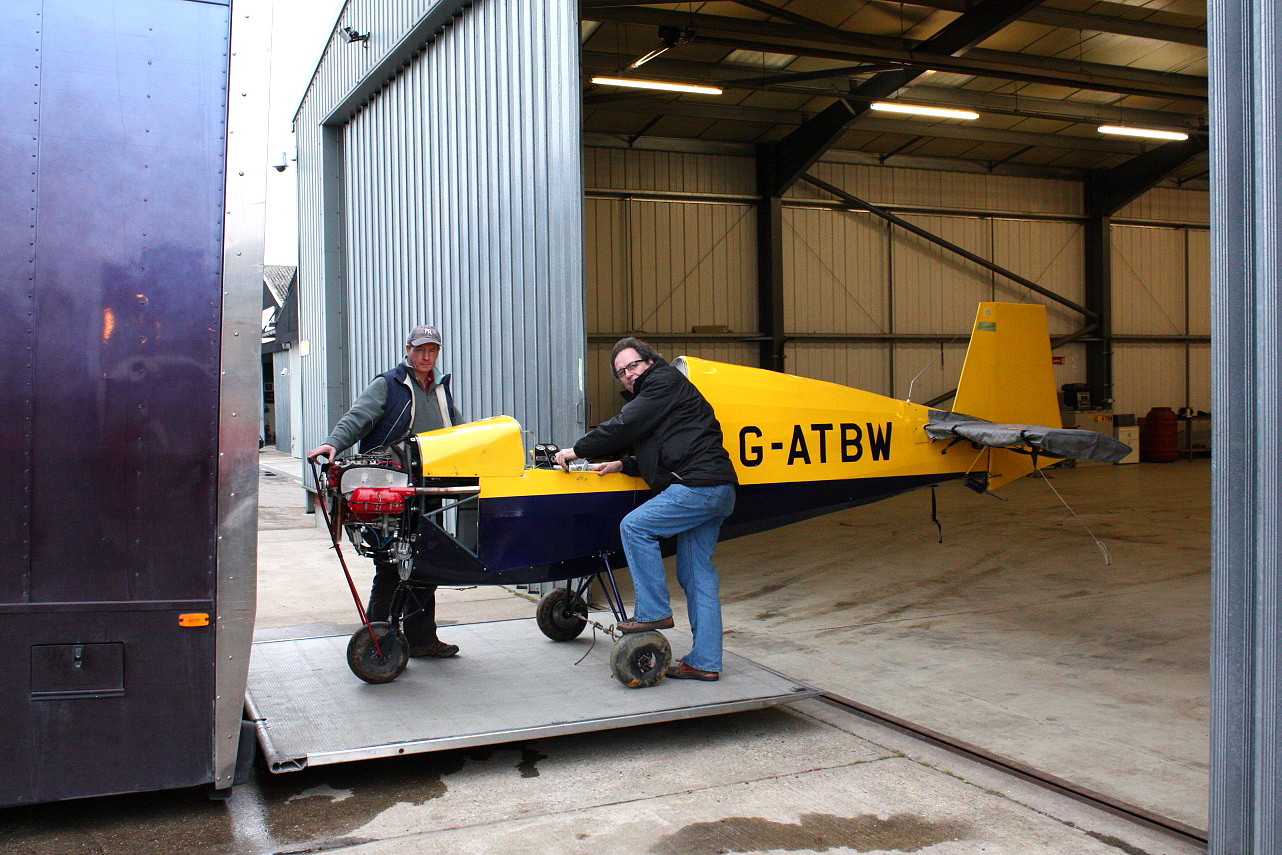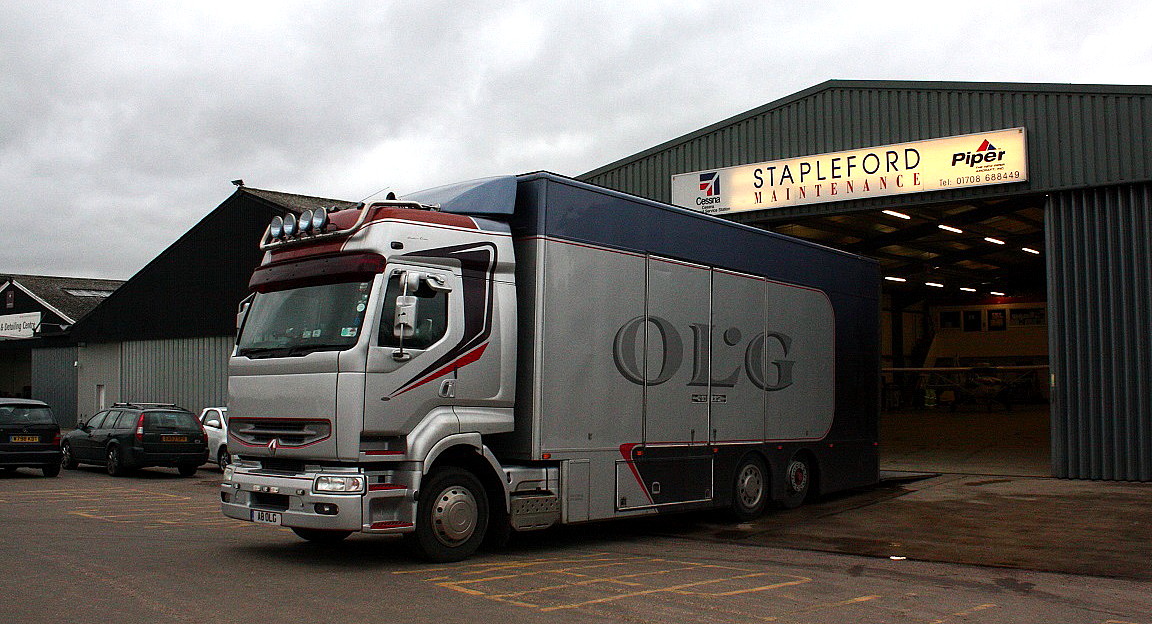Stapleford
STAPLEFORD TAWNEY: Civil regional airport, (Aka ESSEX AIR PORT*** and ABRIDGE)
Military aerodrome in WW2 later civil aerodrome. (Generally later known simply as STAPLEFORD and not to be confused with PIGGOTTS FARM aka ABRIDGE)
Note: All pictures by the author unless specified.
Note: The fourth picture shows the original 'Watch Office', or as we'd call it today. the 'Control Tower'.
Military users: 1930s: 21 E&RFTS
WW2: RAF Fighter Command 11 Group Forward Airfield
(Satellite of NORTH WEALD)
46 Sqdn [Heroes of the Norwegian Campaign] (Hawker Hurricanes)
Coastal Command: 277 (Air-Sea Rescue) Sqdn (Boulton Paul Defiants, Supermarine Sea Otters, Spitfires, Walrus and Westland Lysanders)*
419 Flight: This was a Special Duties, highly secret 'Pick-Up' operation in 1940/1941, operating two or three Lysanders. They also had two Armstrong-Whitworth Whitleys for air-dropping supplies and parachuting agents. It appears they were bombed out at NORTH WEALD and were transferred to STRADISHALL - but also used STAPLEFORD TAWNEY for a short while. Probably just by their Lysanders? Most if not all 'active' operations into mainly France were conducted from TANGMERE in SUSSEX.
Later 419 Flights number was changed to 1419 Flight to avoid confusion with 419 Squadron. For more information, the book 'We Landed By Moonlight' by Hugh Verity is highly recommended.
Operated by: 1934 to 1939: Hillmans Airways, Midland & Scottish Air Ferries
1954 to - : The Herts and Essex Aero Club
Civil activities: Airline, GA private, charter/air taxi, training and maintenance
Note: This DH89A Dragon Rapide operated by Hillmans Airways went on to serve at DYCE (Aberdeen) with Scottish Air Lines during WW2. It is a myth that all civil aircraft were banned from flying during WW2. It later served Allied Airways, also run by E.L.G Dower from 1944 until 1959.
British airlines: Pre: 1940: Hillmans Airways, Midland and Scottish Air Ferries
Flying club/schools: Post 1945: Delta Aviation, Herts and Essex Aero Club, Stapleford Flight Centre, Stapleford Flying Club, Stapleford Flying Group
In the 1957 The Aeroplane directory, the Herts and Essex Aero Club (1946) were operating two de Havilland DH82A Tiger Moths, one de Havilland DH87B Hornet Moth, one Percival Proctor, three Austers and one Miles Gemini. The Stapleford Flying Group were operating one DH82A Tiger Moth.
Maintenance: Post 1945: Stapleford Maintenance, Thurston Engineering
Manufacturing: Edgar Percival, Foster Wikner and Tawney Aircraft**
Location: S of A113, W of B175, E of Abridge, 4.5nm N of Romford
Period of operation: Civil: 1934 to 1939: Military 1939 to 1954: Civil: 1954 to -
Note: The first map was kindly provided by Mr Michael T Holder. The last three maps, for 1965,1993 and 2000 are provided with the kind permission Pooleys Flight Equipment Ltd. Copyright Robert Pooley 2014.
Runways: 1935: E/W 667 grass NE/SW 1152 grass
WW2: E/W 732 grass NE/SW 1036 grass
1965: 05/23 1070x122 grass 11/29 677x91 grass
1990: 04/22 1077x46 grass 10/28 715x46 grass
2000: 04R/22L 1077x46 grass/hard 04L/22R 900x30 grass
10/28 715x46 grass
NOTES: * Some records indicate that 277 Sqdn operated Vickers Warwicks here. This is almost certainly incorrect (?) as it appears the Squadron only operated the type from PORTREATH (CORNWALL) from November 1944 to February 1945. The Squadron seems to have stayed here from December 1941 to December 1942 when it moved to GRAVESEND (KENT). I think a point needs to made here. The roles played by RAF Fighter and Bomber Commands naturally get all the attention these days; But, the roles played by Coastal Command, Transport Command and the Air-Sea-Rescue squadrons were no less hazardous because, put simply, they often flew into hostile territory with little if any effective means to defend themselves.
**Note: According to Ron Smith in his excellent book British Built Aircraft Vol.3 the original Foster Wikner ‘Wicko’ G-AENU first flew here on the 21st September 1936 before the enterprise moved to EASTLEIGH (HAMPSHIRE) with eleven examples built.
EDGAR PERCIVAL
Regarding Edgar Percival, (previously of Percival Aircraft at LUTON). After a tour of New Zealand in 1953 Mr Percival, having seen converted Tiger Moths doing top soil dressing duties, reckoned there was a market for a purpose built aircraft. Other people in Australia for example, were thinking along similar lines. The result was the E.P.9 G-AOFU and it first flew here on the 21st December 1955. It only sold in small numbers going to operators in the UK, France, Germany and several Commonwealth countries. It could not compete nowhere near as well as the Piper Pawnee for example, so inevitably the enterprise folded, being sold to Salmesbury Engineering in October 1958 - see SALMESBURY in LANCASHIRE for final details.
This is perhaps a classic example of not doing market research properly. The altogether superior Fletcher FU-24 having already flown in the USA in 1954, the developments of which are still flying, (and being produced?), in New Zealand to this day. Look up Fletcher crop-dusting on You-Tube to see some pretty exciting footage of how these aircraft operate.
THE TAWNEY OWL
It is also here that another fine example of an aircraft seemingly purpose-built and designed to be relegated to the very long list of failed quirky British designs appeared. In this case the pusher, twin- boom Tawney Owl G-APWU. It ‘flew’ only once, being damaged in the process, on the 22nd April 1960, apparently failing to take-off successfully. As a pilot I was greatly impressed by once reading the advice, “Never fly the Mk.1 of anything”! I was also told the most dangerous words in aviation are; “Now then…watch this.”
A MIKE CHARLTON GALLERY
Note: These lovely pictures from postcards were kindly sent to me by Mike Charlton who has an amazing collection. See, www.aviationpostcard.co.uk
First picture: This shows three de Havilland types operated by Hillmans Airways. From left to right the DH84 Dragon, DH80A Puss Moth and a DH83 Fox Moth. Of interest is that the caption; "Essex Air Port, Abridge" is incorrect. The aerodrome at ABRIDGE was a few miles away - this was ' Essex Air Port' STAPLEFORD.
The DH84 Dragon G-ACAO later went on to serve with Western Airways based at WESTON aerodrome, Weston-super-Mare from July 1938 until April 1940. It was then impressed into the RAF as X9398, and not surprising at all, soon after they crashed it.
Second picture: How about this for a really anoraky detail. In virtually everything you can find about Hillmans Airways, it is spelt with an apostrophe - Hillman's. But this sign over the hangar clearly shows it wasn't used.
Third picture. This seems interesting, for me at least. A search into the history of the DH80A Puss Moth G-ABVX reveals that instead of being registered to Hillmans Airways as I had expected, it was actually registered to Mr Charles Goldsmith at Stapleford. Perhaps an early example of somebody seeking to make money out of owning an aeroplane by renting it out?
BACK TO THE 1930s
In June 1934 Hillman’s Airways transferred their main operating base from ROMFORD, (MAYLANDS – aka ESSEX AIR PORT), to STAPLEFORD with services extending as far as Northern Ireland and Scotland using ‘state of the art’ de Havilland DH.84 Dragons configured to Mr Hillman’s specific requirements. See MAYLANDS for a more exact appraisal of the early history of both the airline and the DH.84 Dragon.
I am indebted to Neville Doyle in his book The Triple Alliance for helping me try to get the story straight. As I now understand it, (in Feb 2013), it was the agreement made with Midland and Scottish Air Ferries to provide Hillman’s Airways with connecting services to Liverpool (SPEKE), the Isle of Man (RONALDSWAY), Belfast (ALDERGROVE) and Glasgow (RENFREW) which commenced on the 9th April 1934 from MAYLANDS that somewhat forced the move to a larger aerodrome, STAPLEFORD TAWNEY being chosen. However, no sooner was the move being completed when John Sword, the owner of Midland & Scottish Air Ferries, was forced, through his directorships in conflicting businesses, to close this airline down. He must have kept ‘Ted’ Hillan informed because, according to Neville Doyle: “…John Sword was obliged to close down MSAF and his London service ended on Saturday, July 14th, 1934. The following Monday, July 16th, Hillman’s reopened the Liverpool – IOM – Belfast service from their new aerodrome at Stapleford.”
This is therefore, (what an anorak I have become), probably sufficient proof to indicate that for a very short period, Midland and Scottish Air Ferries operated into STAPLEFORD? It also appears that as well as being the ‘launch customer’ for the DH.84 Dragon, Hillman’s Airways were one of the first to operate the DH.89 Dragon Rapide, their first obtaining its C of A on July 5th 1934. It might be of interest that an advert in The Aeroplane placed by ‘THE DE HAVILLAND AIRCRAFT CO. LTD’ referred to the ‘Dragon Rapide’ as: “DRAGON SIX HIGH SPEED TRANSPORT AIRCRAFT maintain the fastest daily Air Service between LONDON and PARIS on the lines of HILLMAN’S AIRWAYS”.
So, perhaps the DH.89 was initially known as the ‘Dragon Six’? The ‘Dragon Rapide’ title applying to the DH.89A version?
As said elsewhere, the Dragon Rapide was more advanced in many ways, but nowhere near as easy to fly, especially into the smaller regional ‘airports’ and much more so in demanding weather. It does seem a tad odd that Hillman’s did not acquire any of MSAFs aircraft although it appears two MSAF pilots joined Hillman’s.
ANOTHER LEARNING CURVE
Without too much doubt Hillman’s Airways founded this airport, (or should that be ‘established’?), later to become a GA aerodrome after WW2. I have flown from and into STAPLEFORD several times over many years, it’s a very nice airfield - but I had never realised, until researching this Guide, it was once an important regional and even international LONDON airport – in fact the third ‘LONDON’ airport after CROYDON and HESTON in the latter half of the 1930s.
***I now know that the title ‘ESSEX AIR PORT’ was transferred here from MAYLANDS because it appears on an United Airways timetable published in 1935.
THE HILLMAN'S AIRWAYS FLEET
As said the Hillman’s Airways fleet were mainly based in ESSEX, initially at MAYLANDS and later at STAPLEFORD (as we now know it). It would seem that since the move from MAYLANDS in July 1934 the fleet through to 1939 included:
DH 60G Moth G-ACGX
DH 80A Puss Moth G-ABVX
DH 83 Fox Moths G-ABVI & G-ABVK
DH 84 Dragons G-ACAN, G-ACAO, G-ACAP, G-ACBW, G-ACEU & G-ACEV
DH 86s G-ADEA, G-ADEB & G-ADEC
DH 89 Dragon Rapides G-ACPM, G-ACPN, G-ACPO, G-ADAG, G-ADAH, G-ADAJ,
G-ADAL & G-ADDF
(Twenty one aircraft)
IN REMEMBERANCE
Again from Neville Doyle: “On the last day of 1934, at 5.25 am, Ted Hillman died at the early age of 45…” There was “a magnificent funeral” in Romford. Perhaps somewhat surprising, given the demise of such an autocratic ‘leader’ the company continued, despite inevitable ‘internal’ management problems. This also seems worth mentioning: “At Stapleford, even in mid-winter, large crowds were turning up on a Sunday to watch joy-riding and other activities.
"On January 20th, for instance, there were nearly 300 cars parked in the enclosure and between 200 and 300 people flew. Five or six Dragons and Dragon Sixes (Rapides) were flying together, sometimes in formation, and there were parachute descents by Mr W Hire. The last few flights, made with navigation lights and cabin interiors lighted up, were pretty..’ (‘The Aeroplane’ – January 23rd 1935)”.
A COUPLE OF STORIES
Two stories told by Neville Doyle also make me strongly recommend his book The Triple Alliance. The first concerns a flight to Paris on the 26th January 1935 when the cargo carried in the Dragon G-ACEV included gold bullion. During severe turbulence it dropped through the floor! And, was recovered. The second involved a suicide pact between two sisters (Jane and Elizabeth du Bois – daughters of the US Consul-General in Naples ) flying, also in G-ACEV to Paris on the 21st February 1935. They jumped out over Upminster, a quite bizarre story.
Just two examples of how, exploring the history of UK flying sites it soon became a totally fascinating subject to study. And, I still don’t understand why so many UK airfields don’t openly display and celebrate their illustrious history.
HILLMAN AIRWAYS SERVICES
In the summer of 1935 Hillman Airways daily schedules included for example; four return trips to Paris, two to Liverpool (SPEKE), Belfast (ALDERGOVE) and Glasgow (RENFREW), three to Ostend, Brussels and Antwerp, and, last but hopefully not least, one to RAMSGATE which had a small but superbly designed ‘Art Deco’ terminal building. This terminal building wasdemolished, (by the most utterly delinquent sort of suit and tie wearing ‘developer’ scum), in the 1980s. Not that I am biased – obviously.
Initially Hillman’s flew to CHEESEMAN’S FARM (RAMSGATE) before the ‘proper’ airport opened in July 1935.
NEVILLE STACK
Neville Doyle also mentions the ukulele playing Neville Stack who had previously been the CFI (Chief Flying Instructor at the Lancashire Aero Club when based at WOODFORD (CHESHIRE). “The arrival of Neville Stack had produced a considerable smartening up at Stapleford and all officials from Stack down were in uniform, and all engineers and their apprentices were in official overalls. Offices, workshops and hangars were tidied up, the pilots given their own rest room, and mess huts provided for the engineers. Stack had his own office with everything card-indexed, and numerous return sheets for practically every activity. Regulations were issued to cover all eventualities and proper boundary and obstruction markings were laid out, with some levelling of ground where subsidence had taken place.”
AN ARRANGEMENT?
It now appears probable that Hillman’s Airways had a reciprocal arrangement with United Airways to carry passengers onwards from Liverpool (SPEKE) and many such arrangements existed making it very difficult indeed to determine exactly whose actual aircraft flew the routes. Much the same applies today of course. If you book a ticket with XXX airline, how many passengers actually care who really operates the aircraft?
THE AMY JOHNSON CONNECTION
Also from Neville Doyle and The Triple Alliance: “The most famous pilot to fly for Hillman was, undoubtebly, Amy Johnson who made 16 return trips from Stapleford to Le Bourget in the 21 days from August 23rd to September 12th 1934 and in addition carried out 11 hours of joy-riding. She had just returned from the USA, and she and her husband, Jim Mollison, were preparing to take part in the England – Australia MacRobertson air race in the black and gold D.H. Comet, G-ACSP, due to start from Mildenhall on October 20th.
The Hillman interlude was probably more of a publicity stunt than anything else, but it did give Amy some flying at no cost to herself, and she certainly took the job seriously. Initially she was filmed talking to the passengers (actually spectators), climbing into a Dragon, and sitting at the controls with Ted Hillman swinging the props, but the Dragon they filmed taking off was the next routine departure of a machine on the regular service and Amy was not on board. When she did fly to Paris she had an escort and “Flip” Fleming was one of these. She did not hold a license to operate the radio so the escort kept in close company and sent messages for both. “Flip” claimed also that he carried those passengers who did not want to be flown by a woman. Amy Johnson or not! Fortunately, at this time of year, traffic would have been sufficient to warrant a duplicate service. However, determinedly independent as ever, she flew to Croydon in “Jason 4” on September 12th for her Wireless Exam and then returned to Stapleford in time for her last trip for Hillman’s.”
AN ACCOUNT BY 'FLIP' FLEMING
In his excellent biography, Amy Johnson - Enigma in the Sky, David Luff quotes this from the memory of the late Wing Commander G D 'Flip' Fleming. "Fleming remembered that he was asked to escort Amy on her flights to Paris for a few days, and he got to know her quite well. They would have lunch together at Le Bourget airport and sit and chat before flying back."
"He said: 'She had large blue eyes that flashed about in a rather nervous manner. She seemed shy and nervous in public places, but frank and sincere when we were alone. I don't think she became a famous pilot due to any natural gifts. Technically speaking, her flying was not above average, and her landings were erratic; her navigation and airmanship were mastered by sheer hard work and not instinct, but her courage, determination and endurance in the face of these odds was all the more remarkable.'
SOMETHING OF INTEREST
Neville Doyle also states: “…on October 1st, Vivien Rait caught the 10.00 am Paris flight from Stapleford. She discovered that ‘it was possible to fly to Paris more cheaply even than to go second class by train and boat – never a desirable undertaking..’ (‘Airways and Airports’ – 1934).” The Hillman’s Airways flight time to Paris in a DH Dragon took just over two hours and I suspect the train probably took much longer just to reach Dover? Perhaps something to reflect on that it wasn’t until 2007 that a direct train service from London to Paris could match these times. Indeed, a later special record breaking train made the journey in 2hrs 3mins 39secs – and this did of course arrive at the Gare du Nord from St Pancras. Oddly enough almost exactly the same ‘direct line’ distance as Stapleford to Le Bourget! The train has to travel quite a bit further of course, but, even so I trust you’ll agree – an interesting comparison given the 73 years separation. One aspect well worth thinking about is that anybody today travelling from the centre of London to the centre of Paris, (or Brussels), and deciding to fly, will be very challenged to beat the ‘total’ journey times established in the 1930s.
Once again from The Triple Alliance Neville Doyle gives a very comprehensive account of the fatal crash involving the Dragon G-ACPM on the 2nd October 1934, which had departed from STAPLEFORD to Le Bourget in France. The pilot perished as did six passengers. It is a quite astonishing account, clearly indicating that Hillman was not operating his airline in a responsible manner, and yet, despite a damning account from the Air Ministry Accident Report, Hillman’s Airways were allowed to continue operations.
On the 19th June 1935 Hillman’s Airways began a new service to the Continent; from STAPLEFORD to Ostend and Brussels initially using their Dragon Rapides. It appears the aerodrome at Ostend was deemed too small so they changed to Knocke-Le Zoute. I find this very interesting, as it appears that Hillman’s Airways had identified Ostende as being a desirable holiday destination, (along with the nearby resort of Blankenberge presumably?) If so they had anticipated this stretch of coast in Belgium becoming a hugely popular foreign holiday destination for many Brits after WW2.
The airport in Brussels was at Haren, about 3 miles NE of the city and in July an extension to Antwerp (Deurne) was added. What the mix was, of holidaymakers vs business users is not recorded. I suspect mostly business traffic to Brussels and Antwerp?
NEVILLE BROWNING
Reading about this airfield, during the mid 1960s it makes very interesting reading for me at least. Neville Browning was the CFI of the Herts and Essex Aero Club. Aged 66 he was reckoned to be the oldest commercial pilot to be flying in the UK and was regularly flying abroad. At that time it seems the club operated four Aircoupe F1As, a Piper Tri-Pacer, a Piper Cherokee, a Percival Prentice, (ostenstibly much used by the Essex Parachute Club…..really?), a DHC.1 Chipmunk and a Piper Twin Commanche. Other aircraft types owned by Club members in 1966 seem to make very interesting reading, for example who would credit a Auster J1 and J1S, Beagle Airedale and Terrier, a Beechcraft 23, two Bücker Jungmeister, a DH Moth Minor, Jodel D.140 and Luton Minor. Plus two Miles Messengers, a Mooney 21, Piper Tri-Pacer and Cherokee, a Rollason Turbulent, a Tipsy Nipper, plus two helicopters, a Brantley B.2 and a Bell 47.
A PERSONAL STORY
On a more personal note I married my lovely Australian wife in 1973 and decided, en route to our ‘one night’ honeymoon near Steeple Bumpstead, (don’t ask - it’s a long story), to, on the spur of the moment, really show-off and impress her, ducking into STAPLEFORD along the way, and booking an impromptu trial lesson. Afterwards, anxious to know how impressed she had been to actually fly in a light aircraft, she then told me she’d already made several parachute drops in Oz!
I know it was in a PA.28 so presumably it was a PA-28 Cherokee the Herts & Essex Aero Club were operating? Another reason for mentioning this is because the role of the humble joy-ride, pleasure flight and trial lesson cannot be over-emphasised. Apart from the short event giving so much pleasure and thrill to hundreds of thousands, countless others have then been inspired to learn to fly and some went on to become some of the greatest and most famous of pilots.
ANOTHER ASPECT
In compiling much of this information of necessity I have often resorted to consulting various pilot flight guides. Is there a better source for accurate information I asked myself when starting the project? Sadly I found so many errors, often with contradictory information on the page itself, that I now find my decision just to provide proof of the existence of any particular site was a wise move indeed. This aerodrome is an excellent example with the map in one guide showing 04L/22R as being 1077x30 grass but the written information states it is 900m long! Conversely the map shows 04R/22L as 900x46 grass/hard but the written account says it is 1077m long. To further confuse matters the map clearly shows that 04L/22R is the longest runway but in another flight guide the map shows 04R/22L as being the longest! Which one should a pilot believe?
PERSONAL MEMORIES AND PICTURES
Apart from landing here I have also visited in my truck. On particular visit stays in my memory when I was tasked, in February 2011, with transporting the Tipsy Nipper G-ATBW from Flemming Farm near Billericay back to STAPLEFORD. The pilot, Neil Rankin had experienced his propeller flying off in flight and had made a perfect dead-stick landing. Such are memories made of. Just a note - I think my truck is pictured outside the hangar first used by Hillmans Airways in the 1930s.
alan hardy
This comment was written on: 2016-02-29 22:20:37yes the watch office was the control tower i was an apprentice with thurstons from 1960 and helped build the office and control tower and flew a lot with neville browning happy days
Marion Burke
This comment was written on: 2016-08-07 20:33:37In the 1930's my parents were stewards at Theydon Bois aero club.It may have been at Abridge and they lodged at Theydon, im not sure. I was not born till 1943 but my parents knew Neville Browning well and me took my mother up in a very small , open top plane and did loop the loop. about 15 years ago I made enquiries about the whereabouts of the air club and was informed it was now called Stapleford Abbotts. I did send a few newspaper cuttings of interest to them. My parents also knew Joan Hughes who transported planes in WW2. Can you please tell me if Theydon Boise/ Abridge is now Stapleford Abbotts
Reply from Dick Flute:
Hello Marion, Many thanks for your enquiry. It has reminded me to now add Piggotts Farm, aka Abridge, Loughton Air Park and Loughton Aerodrome to this web-site. I had a great deal of trouble trying to disentangle this, and I am not at all surprised that you feel confused - I certainly was. But, as you will see, I have not found as yet, any mention of a Theydon Bois Aero Club being based here. I will welcome any proof you have so that I can remove the question mark. My best regards, Dick
Alan Simpson
This comment was written on: 2017-07-04 09:12:41I've been researching the history of Abridge aerodrome (the short-lived one north-west of Abridge village, aka Loughton Air Park, or Loughton aerodrome (Abridge), ie. not the one at Stapleford). I've accumulated a great deal of information - but very few photographs. If anyone would like a summary of my research, I'll happily send you an updated version of an article I wrote for Loughton & District Historical Society's newsletter.
Reply from Dick Flute:
Hi Alan, Many thanks for this information which I shall keep posted. If you could kindly e-mail me a copy this will be much appreciated. And well done, I found it very difficult to unearth material on Abridge. Best regards, Dick
We'd love to hear from you, so please scroll down to leave a comment!
Leave a comment ...
Copyright (c) UK Airfield Guide















